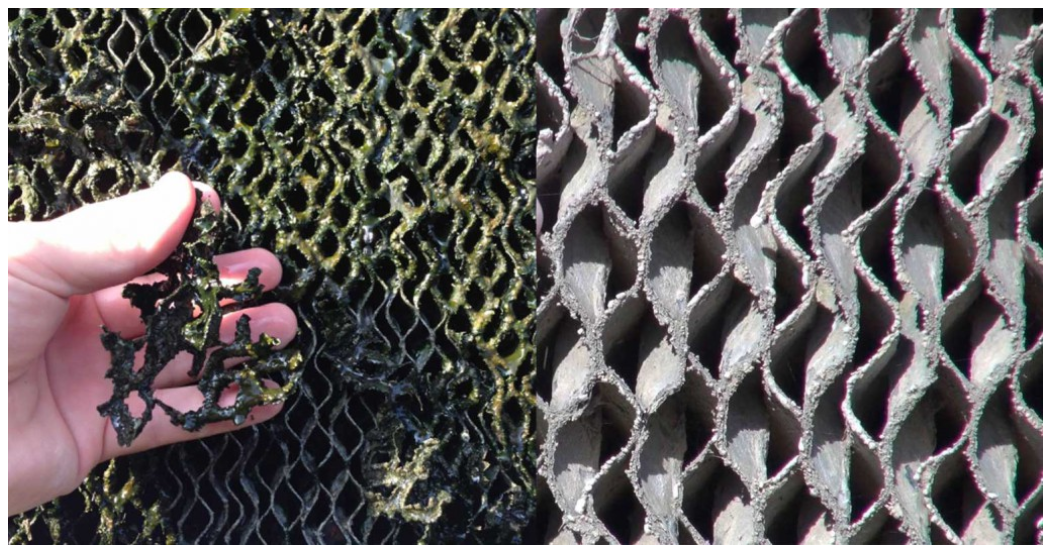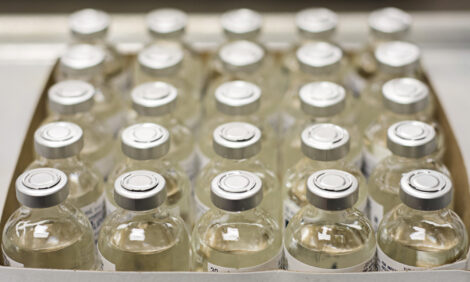



What's all that gunk on my cool cell pads?
Allowing mineral deposits and algae to accumulate on evaporative pads will eventually clog the pad openings causing a restriction of the airflow into the building.When water evaporates, pure water is released leaving behind mineral deposits on the cool cell pads. The single best way to prevent the accumulation of mineral deposits is proper water distribution. Steady water flow over the pad surface flushes away minerals left by evaporation. In a system that is operating correctly, you should see a steady trickle of water down the outside of the pads with no visible dry streaks.
1) Start with clean pads. Remove dirt and other debris from the pads using a soft brush and low-pressure hose end sprayer. To remove heavy deposits of mineral and scale use a chemical cleaner like Triple-C® by Proxy Clean. Avoid using high-pressure sprayers and harsh chemicals containing bleach which can damage the pad media.
2) Clean the spray bar. At the beginning of every season, open the ball valve on the pipe end; turn the pump on and flush water out the end. It is a good idea to mechanically scrub the inside of the pipe with a bottlebrush attached to a long PVC pipe. An inexpensive Clean-out Brush is also available with a slip coupling that glues directly to a ¾” PVC pipe. Run the brush through the pipe and turn the pump on to flush the system a second time.
3) Clean the sump. Flush the trough and sump as dirt and sand quickly cause filters to plug. Remove several sections of pad and check the trough covers. Some trough covers have only minimum drainage holes, which allow dirt and sand to accumulate.
4) Flush the filters. Install a ball valve on the filter clean out making it easy to remove trapped sediment. The screen element should be cleaned often and replaced every six to twelve months.
5) Flush don’t bleed. While “bleeding-off” is better than nothing, a much better practice is to dump all the water from the trough and replenish it with fresh water. The complete dumping helps to flush the containments out of the cool cell pads. How often the trough needs to be drained depends on the hardness of the water and how often the evaporative system operates. Monitoring the pH level is a useful method to determine when to change the water with readings above 8.5 indicating an excessive mineral buildup.
6) Check the pump size. Many times evaporative systems are extended without changing to a higher gallons per minute pump. Dry areas showing up at the end opposite the pump usually means an undersized pump. You can quickly check the pump size by using these general calculations:
4-inch pads require .50 gallons per minute per linear foot
6-inch pads require .75 gallons per minute per linear foot
Cool cell pads are the perfect environment for algae growth providing light, moisture, and nutrients. Algae growth can be limited by following a few important management practices.
1) Limit sunlight. Algae growth requires only a few hours of sunlight per day. Cover sumps and filter housings to prevent algae growth. Consider installing an awning or roof to shade the system.
2) Dry the pads. Allow the pads to dry completely once every 24 hours, as algae cannot live on a dry surface. If the system is not shutting down during the evening hours, it may be necessary to install a 24-hour timer.
3) Limit nutrient content. Water from deep wells or municipal systems is preferred over surface water. Water from ponds or shallow wells is typically higher in nutrients.
Only use chemical treatments approved for use with evaporative cooling systems. Bleach and many pool chemicals may damage the media and metal components. Don’t rely on chemicals to maintain an evaporative pad system. While the periodical use of descalers and algaecides may be helpful, there is no substitute for proper water flow and regular flushing of the system.









